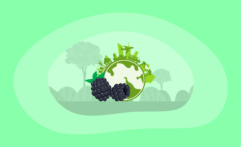The Environmental Impact of Lemons: From Farm to Table
Impactful Ninja is reader-supported. When you buy through links on our site, we may earn an affiliate commission.
Learn more
Learn more
.
Hey fellow impactful ninja ? You may have noticed that Impactful Ninja is all about providing helpful information to make a positive impact on the world and society. And that we love to link back to where we found all the information for each of our posts. Most of these links are informational-based for you to check out their primary sources with one click. But some of these links are so-called "affiliate links" to products that we recommend. First and foremost, because we believe that they add value to you. For example, when we wrote a post about the environmental impact of long showers, we came across an EPA recommendation to use WaterSense showerheads. So we linked to where you can find them. Or, for many of our posts, we also link to our favorite books on that topic so that you can get a much more holistic overview than one single blog post could provide. And when there is an affiliate program for these products, we sign up for it. For example, as Amazon Associates, we earn from qualifying purchases. First, and most importantly, we still only recommend products that we believe add value for you. When you buy something through one of our affiliate links, we may earn a small commission - but at no additional costs to you. And when you buy something through a link that is not an affiliate link, we won’t receive any commission but we’ll still be happy to have helped you. When we find products that we believe add value to you and the seller has an affiliate program, we sign up for it. When you buy something through one of our affiliate links, we may earn a small commission (at no extra costs to you). And at this point in time, all money is reinvested in sharing the most helpful content with you. This includes all operating costs for running this site and the content creation itself. You may have noticed by the way Impactful Ninja is operated that money is not the driving factor behind it. It is a passion project of mine and I love to share helpful information with you to make a positive impact on the world and society. However, it's a project in that I invest a lot of time and also quite some money. Eventually, my dream is to one day turn this passion project into my full-time job and provide even more helpful information. But that's still a long time to go. Stay impactful,Affiliate Disclosure
Why do we add these product links?
What do these affiliate links mean for you?
What do these affiliate links mean for us?
What does this mean for me personally?
![]()
Lemons are a fantastic and diverse fruit, with over 40 different species existing globally. They have many health benefits, as an excellent source of vitamin C and fiber. They’re also very useful from a culinary perspective, being staples in drinks, baked goods, and even general-purpose cooking. But lemon production can also significantly harm the environment with many aspects of their cultivation. So, we had to ask: What is the environmental impact of lemons?
Lemons have a fairly negative environmental impact. This is because they use considerable pesticides and irrigation, as well as harmful fertilizers and farming practices like monocultures. However, both their land requirements and their carbon footprint are fairly low.
In this article, we will examine the environmental impact of lemons from several different angles. We will go through the life-cycle of lemons, detailing their impact on the environment from growth to distribution to your plate to waste management. We will then compare the environmental impact of lemons to that of other fruits. And, finally, we’ll share some tips with you on how you can reduce your own environmental impact and offset your own carbon emissions—both for your personal life and lemon-related.
Here’s How We Assessed the Environmental Impact of Lemons
The Environmental Impact Assessment (EIA) is one of the ways we measure the potential environmental effects of our actions, like the consumption of lemons. It is a holistic assessment based on the environmental changes associated with our consumption. Those are changes in our environment that can have adverse effects on the air, land, water, fish, and wildlife or the inhabitants of the ecosystem.
“Environmental Impact: the effect that the activities of people and businesses have on the environment”
Cambridge Dictionary
Basically, all goods and services you buy—including lemons—leave an impact on our environment. When it comes to food in general, and lemons specifically, the following are key factors:
- Land requirements: Large parts of the world that were once covered by forests and wildlands are now used for agriculture. 10 million hectares of forest are destroyed annually and 50% of the world’s habitable land is now used for agriculture. This loss of natural habitat has been the main driver for reducing the world’s biodiversity.
- Water footprint: 70% of global freshwater is now used for agricultural purposes. By assessing the water footprint of a particular food, we can determine how our limited freshwater resources are being consumed and polluted.
- Pesticide and fertilizer usage: Pesticides and fertilizers provide a range of agricultural benefits. However, numerous studies link pesticides and fertilizers to serious effects on human health, along with disruptions to vital ecosystems and the spread of aquatic dead zones.
- Carbon footprint: The carbon footprint is one of the ways we measure the effects of our human-induced global climate change. Today, food production accounts for over a quarter (26%) of global greenhouse gas emissions.
- Waste generation: Food and its packaging account for almost 45% of the materials landfilled in the US alone. And packaging sent to landfills, especially when made from plastics, does not degrade quickly or, in some cases, at all.
To understand the overall environmental impact of lemons, we must assess each of their key factors. This Environmental Impact Assessment (EIA) is a tool originally developed to identify the environmental impacts of a project prior to decision-making and also helps us to evaluate the environmental impacts of lemons, from farm to table.
Here’s the Overall Environmental Impact of Lemons
The overall environmental impact of lemons is moderately high. The main factors that lead to this are their use of monoculture farming, high irrigation requirements, significant pesticide use, and the application of harmful fertilizers like phosphorus and nitrogen.
That being said, lemons have some good qualities in terms of their environmental impact. For example, they have a very low carbon footprint and don’t use plastic packaging. However, they still have many other factors that raise their negative environmental impact considerably.
So, let’s have a look at the environmental impact of each key factor of lemons!
| Key Assessment Factors | Environmental Impact |
| Land requirements for lemons | Lemons’ land requirements are fairly low. However, they have been identified as participating in deforestation, desertification, and monoculture farming, which means that their land footprint is moderately high. |
| Water footprint of lemons | Lemons have a moderately high water footprint of 60 inches of water per year. Because of where they are grown, they require a high amount of irrigation, meaning their environmental impact is high at this stage. |
| Agrochemical usage for lemons | Lemons’ agrochemical usage is high. The specific agrochemicals they use, such as nitrogen fertilizer and fungicides, are particularly harmful. |
| Carbon footprint of lemons | The carbon footprint of lemons is 0.09kg (0.19lbs) CO2e per pound of lemons, which is fairly low compared to other fruits. The main contributing factors to their carbon footprint are the pesticides used in production, long transportation distances, and the lack of proper waste management. |
| Waste generation of lemons | Lemons’ waste generation is moderate. They use cardboard packaging, which is easily recycled but has low composting rates. |
These are the overall summaries, but there is a lot more to the story. In the next few sections, we will dive deeper into each stage to illustrate to you all the important aspects of lemons’ environmental impact.
What Are the Land Requirements for Lemons
Lemons’ land requirements are fairly low. However, they have been identified as participating in deforestation, desertification, and monoculture farming, which means that their land footprint is moderately high.
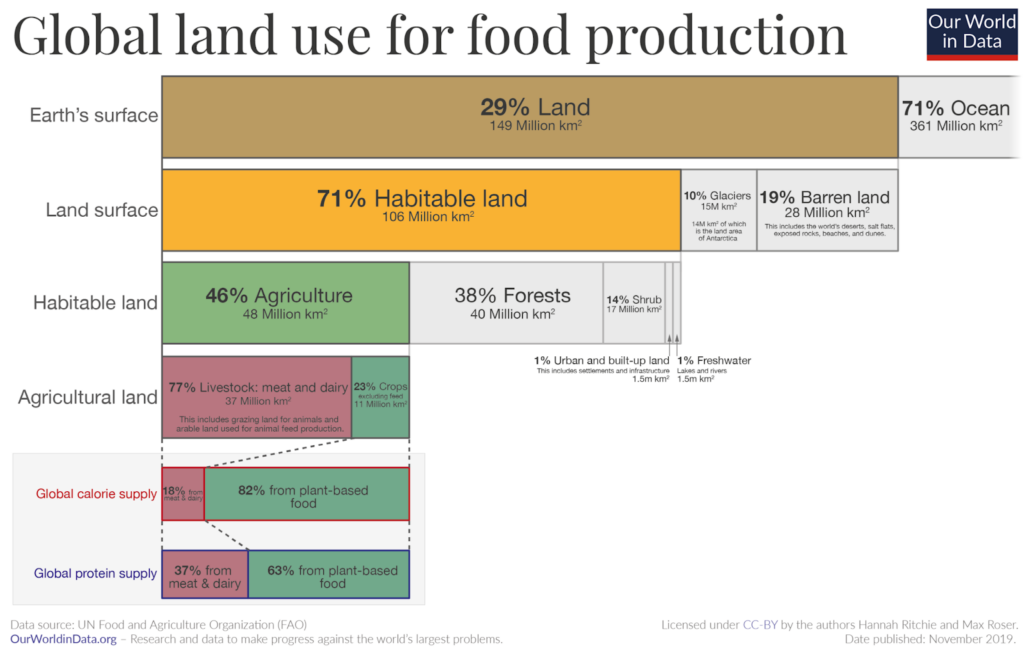
Growing lemons has a lot of variables that contribute to their environmental impact. The amount of land they use, the way in which they grow, and the amount of time they take to grow will all contribute to their environmental impact.
How do the land requirements of lemons impact their environmental footprint?
- What is the land usage of lemons: Lemons yield around 30–45 tons per hectare. This is a substantially high land yield compared to other fruits. For example, strawberries only yield up to 25 tons per hectare, and watermelons only around 2–3 tons per hectare. Therefore, lemons’ land usage doesn’t contribute significantly to their environmental impact.
- Where and how are lemons grown: Lemons are grown mainly in Mexico on the global stage. Lemons also grow on trees, which are excellent at sequestering carbon, having a higher carbon storage rate than other citrus trees. Carbon storage removes carbon from the atmosphere and sequesters it in the ground. This greatly reduces their carbon footprint and thereby their environmental impact.
- Are lemons grown in monocultures or polycultures: Citrus fruits are generally grown in monocultures, which are very damaging to the environment. Therefore, this category raises lemons’ harm to the environment.
- How does the growing of lemons affect soil fertility and erosion: Citrus farms have been identified as a major driver of soil erosion. Excess soil erosion and depletion of nutrients can lead to a phenomenon known as desertification. Desertification renders vast swaths of land completely uninhabitable and unfarmable, essentially making them into deserts. Lemons’ participation in this process means that their impact on soil is negative.
- How does the lemon industry affect the loss of habitable land: Citrus fruits have been linked to deforestation, especially in the Amazon. Deforestation is not just bad for the specific wildlife and people who live there but can cause chain reactions with global consequences. Lemon being the most common citrus fruit means that they bear the brunt of these issues within the citrus industry, and thus have affected the loss of habitable land considerably.
- How does the lemon industry affect wildlife and biodiversity: Monoculture farming is very bad for wildlife and biodiversity. It prevents pollinators and other wildlife from accessing proper nutrients and can negatively affect soil microbes. Therefore, the lemon industry has caused significant harm to wildlife and biodiversity.
In short, lemons’ tendency to use monoculture farming and participate in soil erosion and deforestation means that their environmental impact is very negative in terms of land.
What Is the Water Footprint of Lemons
Lemons have a moderately high water footprint of 60 inches of water per year. Because of where they are grown, they require a high amount of irrigation, meaning their environmental impact is high at this stage.
Water usage is one of the most important factors in the environmental impact of a fruit. The amount of water used, as well as the way they affect the water sources around them, are all major contributing factors. Here, we will look at these different angles of lemons’ water impact.
How does the water footprint of lemons impact their environmental footprint?
- What is the overall water usage of lemons: Mature lemon trees need about 60 inches of water per year, but young trees need twice this amount. This is slightly above average for fruits. For example, cherry trees only need 35 inches of water per year, but figs need up to 75 inches per year. This means that lemons’ overall water footprint is moderate.
- What is the green water footprint of lemons: The green water footprint is the amount of water from precipitation stored in the soil and used by plants for growth. Most US-consumed lemons are grown in Arizona, which only gets 12 inches of rain per year. Therefore, the vast majority of the rainfall is going toward lemon farming.
- What is the blue water footprint of lemons: The blue water footprint is the amount of water sourced from surface (such as rivers or lakes) or groundwater resources. Since Arizona’s annual rainfall is nowhere near enough to cover lemons’ water requirements, they need significant irrigation. As a result, their blue water footprint is very high.
- What is the gray water footprint of lemons: The gray water footprint is the amount of freshwater required to clean up water pollution to meet certain quality standards. Essentially, it’s the amount of water needed to make polluted water clean enough to be safe and healthy for humans and the environment. As well, since lemons use a significant amount of pesticides, a significant amount of water is needed to clear up their chemical waste.
- How does the lemons industry affect freshwater and ocean pollution: Lemons use lots of pesticides, which are particularly damaging to freshwater sources. The significant amount of irrigation that they use also has an impact on water sources, mainly through over-salination and harming groundwater balance. Between these two factors, lemons have a major impact on freshwater pollution.
In short, lemons’ high rates of irrigation and pesticides mean that their water consumption is higher than other fruits.
What Is the Agrochemical Usage for Lemons
Lemons’ agrochemical usage is high. The specific agrochemicals they use, such as nitrogen fertilizer and fungicides, are particularly harmful.
Pesticides and fertilizers are agrochemicals that can have a significant negative impact on the environment. They both require resources to create as well as have the potential to harm life around them. Here, we will look at how lemons’ pesticide and fertilizer rates affect their environmental impact.
How does the agrochemical usage of lemons impact their environmental footprint?
- What is the pesticide usage of lemons: Lemons use a high amount of pesticides, as well as fungicides. Pesticides can cause many kinds of environmental damage, including poisoning surrounding wildlife, and leakages getting into soil and groundwater. Fungicides in particular are harmful to microorganisms in soil, reducing biodiversity in surrounding areas.
- What is the fertilizer usage of lemons: Lemon trees are typically fertilized with equal parts potassium, phosphorus, and nitrogen. While potassium is generally minimally invasive, phosphorus and nitrogen have been identified as very damaging to the environment.
- Are there any known issues connected to the agrochemical usage for lemons: Lemons are known for using a significant amount of fungicides, which have hormone-disrupting qualities and can even cause cancer. These harmful qualities can be harmful to humans, plants, and animals alike.
In short, the fact that lemons use both a high amount of pesticides, as well as particularly harmful agrochemicals like fungicides and phosphorus and nitrogen fertilizer, means that they have a harmful agrochemical impact.
What Is the Carbon Footprint of Lemons
The carbon footprint of lemons is 0.09kg (0.19lbs) CO2e per pound of lemons, which is fairly low compared to other fruits. The main contributing factors to their carbon footprint are the pesticides used in production, long transportation distances, and the lack of proper waste management.
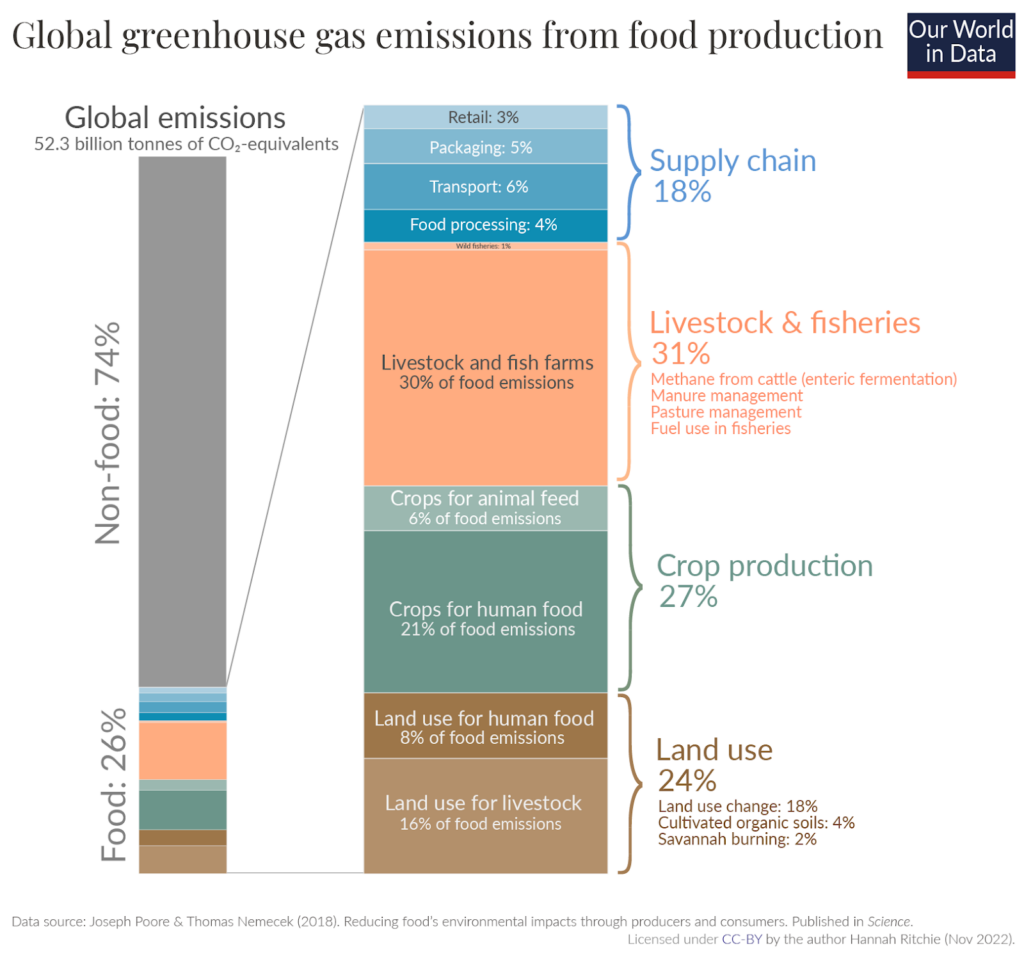
Carbon footprint is one aspect of the overall environmental impact of a fruit. It essentially measures how much carbon or other greenhouse gasses the production of strawberries emits into the atmosphere. Emissions from product manufacturing, irrigation, transportation fuel, and landfills all add up to create the overall carbon footprint of a fruit. Let’s see how the carbon footprint of lemons breaks down and contributes to their environmental impact.
How does the carbon footprint of lemons impact their environmental footprint?
- What is the overall carbon footprint of lemons: The overall carbon footprint for lemons is around 0.09kg (0.19lbs) CO2e per pound of lemons. This means that for every pound of lemons produced, 0.09kg of carbon is released into the atmosphere. This is an extremely low carbon footprint compared to other fruits.
- What are the main contributors to the carbon footprint of lemons: The main factors that contribute to the carbon footprint of lemons are transportation distances, low composting rates, and high pesticide usage.
- Which life-cycle stage of lemons has the highest carbon footprint: The life cycle stage that contributes the most to lemons’ carbon footprint is transportation. This is because lemons have to be shipped to the US from Chile and Argentina and be refrigerated during the process.
In short, though lemons cause some emissions through things like refrigerated shipping and pesticides, they still have one of the lowest carbon footprints among fruits.
What Is the Waste Generation of Lemons
Lemons’ waste generation is moderate. They use cardboard packaging, which is easily recycled but has low composting rates.
When fruit waste in the form of either packaging or organic materials, is disposed of, it can have a major negative impact on the environment. Whether it’s damaging wildlife, getting into oceans, emitting methane, or dissolving into microplastics that contaminate groundwater, all these materials have their part to play. In this section, we will look at how lemons’ waste affects the environment.
How does the waste generation of lemons impact their environmental footprint?
- What is the packaging of lemons: Lemons are typically packaged in cardboard boxes. Cardboard has a moderate environmental impact but still contributes heavily to deforestation. Deforestation has a devastating impact on the environment, destroying habitats and removing crucial biodiversity.
- How is the packaging of lemons disposed of: Cardboard, fortunately, has a very high recycling rate of around 89%. This means that a relatively small amount of cardboard from lemons is ending up in landfills, which is good news for their environmental impact.
- How are lemons disposed of: Lemon peels are biodegradable. However, they often end up in landfills, since roughly only 4% of food waste is composed. This means that the majority of lemon waste is ending up in landfills. Besides the general environmental damage that landfills can cause, food waste in landfills releases methane. Methane is a harmful greenhouse gas that raises lemons’ environmental impact considerably.
In short, the fact that lemons use easily-recycled cardboard packaging helps lessen their negative environmental impact, but their low composting rates mean they still contribute to unnecessary waste in landfills.
What Have Been Historical Environmental Issues Connected to the Lemon Industry
The lemon industry has had a history of causing damage to waters and forests through land clearing and leaking harmful fertilizers.
All fruits have had a complex journey toward global distribution. They originate in one part of the world and often travel far to end up in your local supermarket. From farm to table, some of our favorite fruits have racked up some serious environmental damage along the way. Whether it’s deforestation to meet demand, water pollution, or disruption of wildlife, most fruits have left a path of destruction. Let’s see how lemons have fared throughout history.
What have been the key environmental issues of the lemons industry?
- How much land has been lost because of lemon production: Lemon production has been linked to some major deforestation cases. One in particular concerns an Argentinian farm that has been infringing on national park land, sometimes illegally. Cases like this show how dangerous and damaging large-scale lemon farming has been to the environment.
- Which wildlife species have been negatively impacted or displaced because of lemon production: Deforestation cases like the Argentinian national park incidences, have major impacts on wildlife. Deforestation causes habitat loss, which is the leading cause of wildlife population decline, contributing heavily to endangerment and extinction. Because of their involvement in deforestation cases, lemon agriculture has contributed to species population decline, especially in South America.
- Have water sources and soil been contaminated because of lemon production: Nitrogen and phosphorus fertilizers have both been linked to invasive algae growth, which is particularly harmful to waterways and aquatic life. Their continued use of these fertilizers means that their environmental impact has been harmful to waterways through the years.
In short, lemon agriculture has participated in some very harmful practices over the years, mainly in the deforestation and leaking fertilizer department.
What Is the Overall Environmental Impact of Food and Agriculture
Food production in general has a high environmental impact. Everything from the amount of land used to the energy involved in irrigation to its effect on plant and animal biodiversity can be a factor in this. In the chart below, you can see how food production is one of the biggest influences on these areas of the environment.
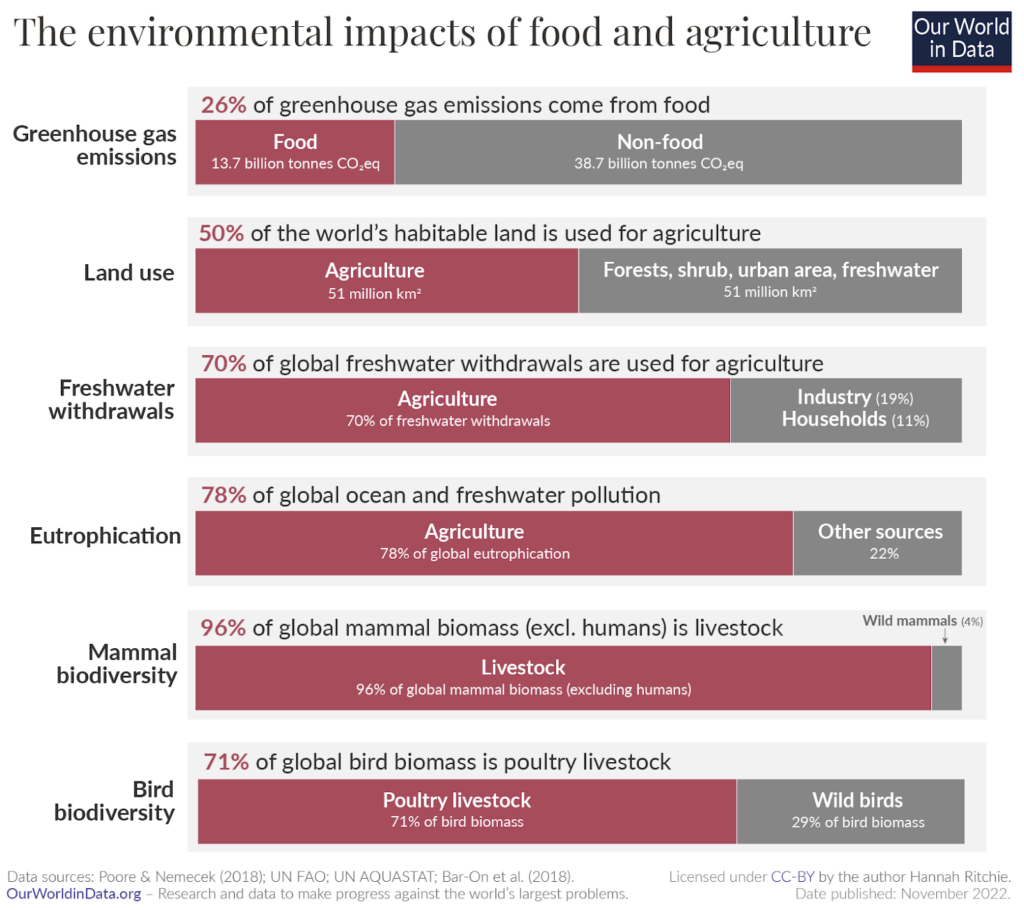
Agriculture alone accounts for over a quarter of global greenhouse gas emissions while using half of the world’s habitable land and 70% of the global freshwater withdrawals. Agriculture also causes 78% of the global ocean and freshwater pollution.
Livestock accounts for the vast majority of non-human mammal and bird biomass. Mammal livestock outweighs wild mammals by a factor of 15-to-1, and poultry livestock outweighs wild birds by a factor of more than 3-to-1.
These statistics highlight the need for sustainable and responsible practices in food production to reduce its impact on the environment. And the need for us to shift toward more environmentally-friendly foods.
How Can You Reduce Your Environmental Impact and Offset Your Personal Carbon Footprint
There are a few things you can do to mitigate some of the negative environmental effects of consuming lemons, while still enjoying them. You can also consider offsetting your personal and lemon-related carbon emissions, which work to remove carbon emissions elsewhere that are then attributed to you. Here, we will walk you through how to accomplish both of these things.
How Can You Reduce Your Environmental Impact When Shopping for Lemons
In this section, we give you a short list of ways you can reduce the negative environmental effects of oranges, based on those parts of the life-cycle of lemons that would otherwise most negatively impact the environment:
- Purchase organic lemons: Pesticide and fertilizer usage is a major issue in lemon farming. Organic farms generally avoid high amounts of chemical pesticides and nitrogen fertilizers and so they are good to support if you want to reduce your pesticide and fertilizer impact. Making the effort to buy organic lemons can greatly lessen your lemons’ impact on waterways and soil.
- Properly dispose of waste: One of the biggest contributors to lemons’ environmental impact is the improper disposal of waste. So, by making sure you compost all lemon peels and recycle any cardboard packaging, you can reduce the impact of cardboard and organic waste in lemons’ life cycle.
- Use the whole lemon: Lemon peels are actually very useful for a variety of things. For one, the zest is a common ingredient in recipes like lemon cakes and salad dressings. But it can also be used in other things like cleaning products and soaps. Challenge yourself to come up with unique uses for the lemon peels instead of throwing them away!
Following some of these methods can really help you cut down on your environmental impact of eating lemons. None of these will completely eradicate the negative impacts, since there are always effects that may be outside of your control. But some reduction is always better than nothing!
Which Organizations Can You Support to Help Alleviate Your Environmental Impact
While lemons can cause a wide range of environmental damage, there are also some organizations that help you reduce parts of your impact that would otherwise be outside of your control. These organizations are working hard to prevent and reverse damage to the environment caused by industries like lemons agriculture.
In the table below are some of the best environmental charities that work in the areas where lemons production has affected the environment—and beyond:
Though it is helpful to reduce the environmental impact of your personal lemon consumption, supporting these organizations takes your positive impact a step further. You will be reaching far beyond your own consumption impacts and helping to build a better world for everyone!
How Can You Offset Your Personal Carbon Footprint
The carbon footprint is a key part of your environmental impact. And it is one of the ways we measure the effects of our human-induced global climate change. Yes, even from eating lemons!
“Carbon footprint: the amount of greenhouse gasses and specifically carbon dioxide emitted by something (such as a person’s activities or a product’s manufacture and transport) during a given period”
Merriam Webster
Basically, it is the amount of carbon emitted by you as an individual or an organization providing you with goods and services—including lemons:
- This includes GHG emissions from producing the products that we use and foods that we eat (e.g., power plants, factories or farms, and landfills),
- GHG emissions from fuel that we burn directly or indirectly (e.g., logistics and transportation, cooling or heating facilities),
- as well as the GHG emissions attributed to how we consume these products and foods.
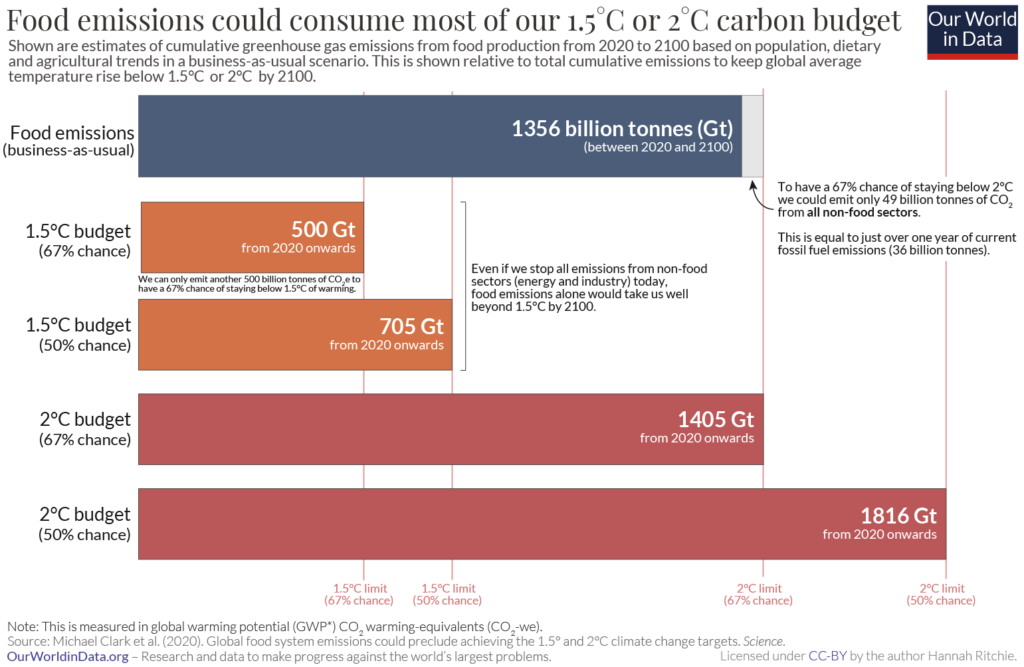
Carbon offsets are reductions in carbon emissions that are used to compensate for carbon emissions occurring elsewhere—for example, for the carbon emissions that are associated with lemons. They are measured in tons of CO2 equivalents and are bought and sold through international brokers, online retailers, and trading platforms on what is known as the global carbon offset market.
“Carbon Offset: a way for a company or person to reduce the level of carbon dioxide for which they are responsible by paying money to a company that works to reduce the total amount produced in the world, for example by planting trees”
Oxford Dictionary
In terms of lemons—and indeed all food types—there will always be a carbon footprint, because of the resources it takes to get your food from farms to the place where you’ll eventually eat them. And while there are ways to reduce your carbon footprint when shopping for lemons, carbon offsets would be a way to reduce your CO2e emissions all the way down to net zero (or even to become climate positive).
However, when you purchase carbon offsets, it’s important that they actually make a difference in offsetting (aka reducing) total carbon emissions. To achieve that, the following are key criteria:
- Carbon offset projects have to be effective (different projects have different effectiveness rates)
- Carbon offset projects have to be additional
- Carbon offset projects have to be permanent
- The claims from carbon offset projects have to be verifiable
To find the best carbon offsets for you personally, check out our full guide on the best carbon offsets for individuals, where you’ll also learn more about how these carbon offset projects work, what their respective offsetting costs are, and what your best way would be to offset your own carbon emissions.
Final Thoughts
Lemons may have a very low carbon footprint, but their environmental impact is anything but low. Their use of harmful farming practices like land clearing and monocultures, as well as their use of pesticides, fungicides, and damaging fertilizers like nitrogen and phosphorus mean that they cause a lot of damage to the environment. Thankfully, there are several steps you can take yourself, as well as organizations you can support to help you lessen lemons’ impact so you can consume them with a more positive relationship to the environment!
Stay impactful,

Sources
- Feast and Field: The Lowly Lemon
- Healthline: Lemons
- Yummly: Fresh Lemon Drinks
- Taste of Home: Best Lemon Desserts
- Recipe Tips: All About Lemons
- UN Environment Programme: Environmental Impact Assessment and Strategic Environmental Assessment: Towards an Integrated Approach
- Our World in Data: The environmental impacts of food and agriculture
- Our World in Data: Global land use for food production
- World Health Organization: Preventing disease through healthy environments: a global assessment of the burden of disease from environmental risks
- ScienceDirect (Biological Conservation): Worldwide decline of the entomofauna: A review of its drivers
- EPA: The Sources and Solutions: Agriculture
- EPA: Reducing Food Waste and Packaging
- FoodPrint: The Environmental Impact of Food Packaging
- Peppers Home Garden: How Much Water Do Lemon Trees Need
- Impactful Ninja: What is the Carbon Footprint of Lemons
- Nepad: Citrus Fruit Yields
- Impactful Ninja: What is the Carbon Footprint of Strawberries
- Impactful Ninja: What is the Carbon Footprint of Watermelons
- Frutas Hortalizas: Lemon Production
- Pennington: How to Grow and Care for an Indoor Lemon Tree
- Ailimpo: Carbon Footprint of the Lemon Sector in Spain
- Green Matters: How Do Carbon Emissions Affect the Environment
- The Independent: Avocados, Coffee, and Citrus Fruits Threaten Global Food Security
- Science Direct: A Systematic Review of Soil Erosion in Citrus Orchards
- Iberdrola: What is desertification?
- WWF: 10 Products and Ingredients that Come From Tropical Rainforests
- PachaMama: Effects of Deforestation
- Gallant Intl: Environmental Impacts of Monoculture
- Impactful Ninja: What is the Carbon Footprint of Cherries
- Impactful Ninja: What is the Carbon Footprint of Figs
- Water Footprint Network: What Is a Water Footprint?
- AZ Climate: Average Annual Precipitation Arizona
- PubMed: Pesticide Residue Survey in Citrus Fruits
- Science Direct: Impact of Pesticides on Freshwater
- FAO: Environmental Consideration in Irrigation Development
- EWG: Hormone-Disrupting Fungicide Found in Citrus
- Friends of the Earth: Effects of Pesticides on Wildlife
- USGS: Pesticides in Groundwater
- NCBI: Effects of Fungicide on Soil Microbes
- BacFertilizers: Lemon Tree Fertilizer
- Direct Farm: Potassium
- EPA: Phosphorus
- Mitsui: Reducing the Environmental Impact of Chemical Fertilizers
- The Packer: Lemon Consumption Increases
- EPA: Reducing the Impact of Wasted Food
- TIS: Lemons Transport
- University of California: Lemon Orchard Startup Cost
- TRVST: Environmental Impact of Cardboard
- Also Known As: 12 Interesting Facts About Packaging Waste
- Colorado: Hidden Damage of Landfills
- GOV.BC: Waste Management
- Greenpeace: La Moraleja
- National Geographic: Endangered Species
- EPA: The Issue With Nitrogen Fertilizers
- UVM: Sources of Nitrogen for Organic Farmers
- Plated Cravings: Moist Lemon Cake Recipe
- Food and Wine: Honey Lemon Dressing
- Wonky Wonderful: Natural Lemon Vinegar Cleaner
- Hearts Content Farmhouse: Lemon Soap Recipe
- SN Applied Sciences Journal: Worldwide pesticide usage and its impacts on ecosystem
- Our World in Data: Global greenhouse gas emissions from food production
- Impactful Ninja: Best charities that fight to protect our environment
- Impactful Ninja: Best charities for reforestation
- Impactful Ninja: Best wildlife conservation charities
- Impactful Ninja: Best charities for protecting the Amazon rainforest
- Impactful Ninja: Best charities that protect our national parks
- Impactful Ninja: Best charities that fight for clean water
- Impactful Ninja: Best charities that help conserve our rivers
- Impactful Ninja: Best charities to save our oceans
- Impactful Ninja: Best charities that help farmers
- Impactful Ninja: Best charities for helping farm animals
- Impactful Ninja: Best charities for climate change
- Impactful Ninja: Best carbon offsets for individuals
- Impactful Ninja: Best charities that fight to reduce food waste
- Impactful Ninja: Best charities that fight to end plastic pollution
- Our World in Data: The environmental impacts of food and agriculture
- Our World in Data: Emissions from food alone would take us past 1.5°C or 2°C this century
- Impactful Ninja: Why Is a Carbon Footprint Bad for the Environment
- Impactful Ninja: Best Carbon Offsets for Individuals


